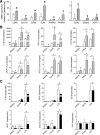Early life exposure to maternal insulin resistance has persistent effects on hepatic NAFLD in juvenile nonhuman primates
- PMID: 24705404
- PMCID: PMC4113070
- DOI: 10.2337/db14-0276
Early life exposure to maternal insulin resistance has persistent effects on hepatic NAFLD in juvenile nonhuman primates
Abstract
The origins of nonalcoholic fatty liver disease (NAFLD) may lie in early intrauterine exposures. Here we examined the maternal response to chronic maternal high-fat (HF) diet and the impact of postweaning healthy diet on mechanisms for NAFLD development in juvenile nonhuman primate (NHP) offspring at 1 year of age. Pregnant females on HF diet were segregated as insulin resistant (IR; HF+IR) or insulin sensitive (IS; HF+IS) compared with control (CON)-fed mothers. HF+IR mothers have increased body mass, higher triglycerides, and increased placental cytokines. At weaning, offspring were placed on a CON or HF diet. Only offspring from HF+IR mothers had increased liver triglycerides and upregulated pathways for hepatic de novo lipid synthesis and inflammation that was irreversible upon switching to a healthy diet. These juvenile livers also showed a combination of classical and alternatively activated hepatic macrophages and natural killer T cells, in the absence of obesity or insulin resistance. Our findings suggest that maternal insulin resistance, including elevated triglycerides, insulin, and weight gain, initiates dysregulation of the juvenile hepatic immune system and development of de novo lipogenic pathways that persist in vitro and may be an irreversible "first hit" in the pathogenesis of NAFLD in NHP.
© 2014 by the American Diabetes Association. Readers may use this article as long as the work is properly cited, the use is educational and not for profit, and the work is not altered.
Figures





Similar articles
-
Switching obese mothers to a healthy diet improves fetal hypoxemia, hepatic metabolites, and lipotoxicity in non-human primates.Mol Metab. 2018 Dec;18:25-41. doi: 10.1016/j.molmet.2018.09.008. Epub 2018 Sep 28. Mol Metab. 2018. PMID: 30337225 Free PMC article.
-
Maternal high-fat diet triggers lipotoxicity in the fetal livers of nonhuman primates.J Clin Invest. 2009 Feb;119(2):323-35. doi: 10.1172/JCI32661. Epub 2009 Jan 19. J Clin Invest. 2009. PMID: 19147984 Free PMC article.
-
Maternal hypoxia increases the susceptibility of adult rat male offspring to high-fat diet-induced nonalcoholic fatty liver disease.Endocrinology. 2013 Nov;154(11):4377-87. doi: 10.1210/en.2012-1683. Epub 2013 Sep 3. Endocrinology. 2013. PMID: 24002036
-
Fructose as a key player in the development of fatty liver disease.World J Gastroenterol. 2013 Feb 28;19(8):1166-72. doi: 10.3748/wjg.v19.i8.1166. World J Gastroenterol. 2013. PMID: 23482247 Free PMC article. Review.
-
Developmental origins of nonalcoholic fatty liver disease.Pediatr Res. 2014 Jan;75(1-2):140-7. doi: 10.1038/pr.2013.193. Epub 2013 Nov 5. Pediatr Res. 2014. PMID: 24192698 Free PMC article. Review.
Cited by
-
In utero inflammatory challenge induces an early activation of the hepatic innate immune response in late gestation fetal sheep.Innate Immun. 2020 Oct;26(7):549-564. doi: 10.1177/1753425920928388. Epub 2020 Jun 14. Innate Immun. 2020. PMID: 32538259 Free PMC article.
-
Maternal Fructose Intake, Programmed Mitochondrial Function and Predisposition to Adult Disease.Int J Mol Sci. 2022 Oct 13;23(20):12215. doi: 10.3390/ijms232012215. Int J Mol Sci. 2022. PMID: 36293068 Free PMC article. Review.
-
Developmental Programming of Nonalcoholic Fatty Liver Disease: The Effect of Early Life Nutrition on Susceptibility and Disease Severity in Later Life.Biomed Res Int. 2015;2015:437107. doi: 10.1155/2015/437107. Epub 2015 May 18. Biomed Res Int. 2015. PMID: 26090409 Free PMC article. Review.
-
Switching obese mothers to a healthy diet improves fetal hypoxemia, hepatic metabolites, and lipotoxicity in non-human primates.Mol Metab. 2018 Dec;18:25-41. doi: 10.1016/j.molmet.2018.09.008. Epub 2018 Sep 28. Mol Metab. 2018. PMID: 30337225 Free PMC article.
-
Maternal obesity has sex-dependent effects on insulin, glucose and lipid metabolism and the liver transcriptome in young adult rat offspring.J Physiol. 2018 Oct;596(19):4611-4628. doi: 10.1113/JP276372. Epub 2018 Aug 29. J Physiol. 2018. PMID: 29972240 Free PMC article.
References
-
- Agopian VG, Kaldas FM, Hong JC, et al. Liver transplantation for nonalcoholic steatohepatitis: the new epidemic. Ann Surg 2012;256:624–633 - PubMed
-
- Modi N, Murgasova D, Ruager-Martin R, et al. The influence of maternal body mass index on infant adiposity and hepatic lipid content. Pediatr Res 2011;70:287–291 - PubMed
-
- Lawlor DA, Relton C, Sattar N, Nelson SM. Maternal adiposity—a determinant of perinatal and offspring outcomes? Nat Rev Endocrinol 2012;8:679–688 - PubMed
Publication types
MeSH terms
Substances
Grants and funding
- P51-OD-011092/OD/NIH HHS/United States
- P51 OD011092/OD/NIH HHS/United States
- UL1 TR000154/TR/NCATS NIH HHS/United States
- R01 DK079194/DK/NIDDK NIH HHS/United States
- K01-DK-090199/DK/NIDDK NIH HHS/United States
- K01 DK090199/DK/NIDDK NIH HHS/United States
- R24 DK090964/DK/NIDDK NIH HHS/United States
- P30 DK048520/DK/NIDDK NIH HHS/United States
- P30-DK-048520/DK/NIDDK NIH HHS/United States
- P30 DK020593/DK/NIDDK NIH HHS/United States
- UL1-TR-000154/TR/NCATS NIH HHS/United States
- R24-DK-090964/DK/NIDDK NIH HHS/United States
- UL1 TR001082/TR/NCATS NIH HHS/United States
LinkOut - more resources
Full Text Sources
Other Literature Sources
Medical
Research Materials
Miscellaneous

